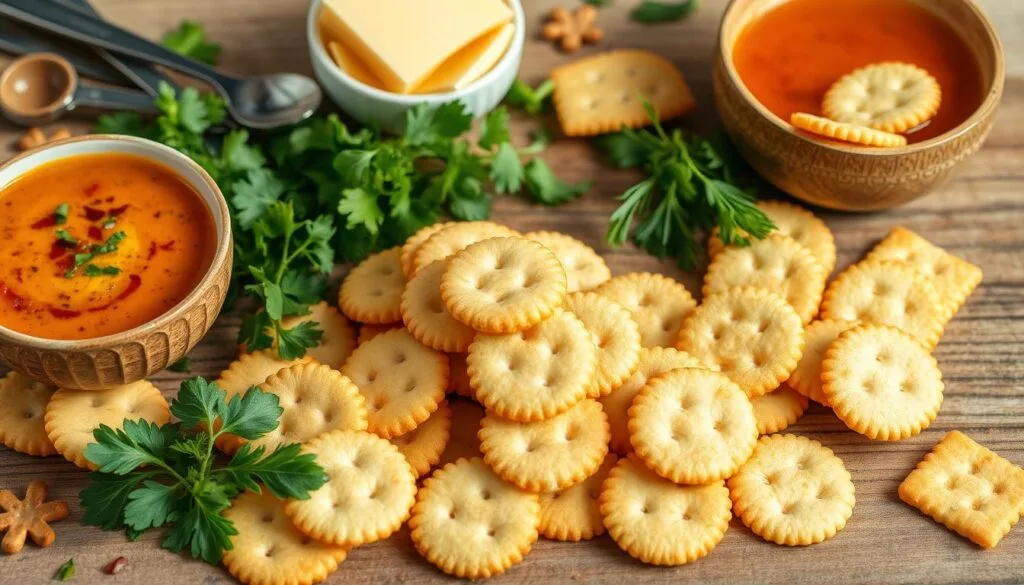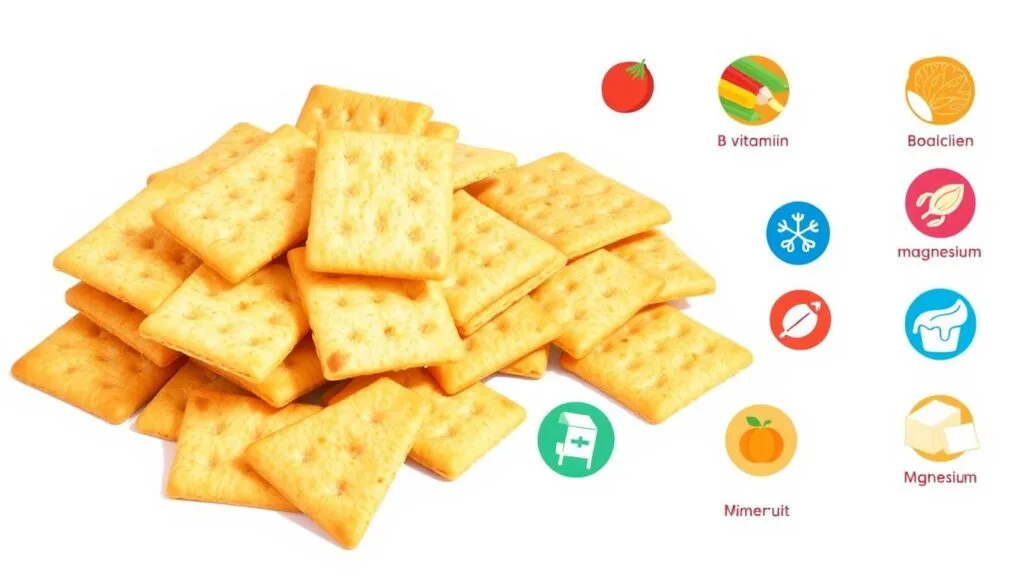Saltine crackers Nutritional Value : Calories, Benefits, and Health value
Saltine crackers are a favorite snack for many. They are light, crisp, and versatile. But what’s their nutritional value? In this guide, we’ll explore their calories, nutrients, and health benefits.
Saltine crackers have 418 calories per 100 grams. They are mostly carbs, with 74 grams per 100 grams. This makes up 26.91% of the daily value. They also have 10 grams of protein per 100 grams, which is 20% of the daily value.

Table of Contents
Understanding Crackers : A Basic Overview
Saltine crackers are a favorite in many homes. They are known for their light, crisp texture and a hint of salt. These snacks have a long history, starting in the late 19th century. Back then, baking soda was added to make them lighter.
What Makes Saltines Different from Other Crackers
Saltine crackers are special because of their ingredients and how they’re made. Saltines carbs and protein are a big part of their nutritional value. Each 15g serving has 11g of carbs and 1g of protein.
This mix of nutrients, along with baking soda, gives them a unique crispiness. This is what makes saltines different from other crackers.
Common Uses and Popularity
Saltine crackers are loved for their neutral taste and versatility. They’re great as a base for cheese or charcuterie boards. They’re also used in cracker crusts for pies or cheesecakes.
People use them as a coating for fried chicken or fish. Their convenience and are saltines healthy qualities make them a favorite snack.
The story of Saltine crackers shows how innovation changes the food world. The introduction of baking soda in the 1870s and the creation of Nabisco in 1898 are key moments. These changes made Saltine crackers a staple in American pantries and a favorite snack globally.
The Saltine Cracker (Soda Cracker) Market is growing worldwide. North America is a big market, while Europe and Asia-Pacific are showing great growth. With new ideas and changing tastes, Saltine crackers have a bright future.
Saltines Nutritional Breakdown per Serving
Looking at saltine crackers, a single serving is packed with important nutrients. A 15g serving of unsalted tops saltine crackers has 60 calories. It’s made up of 72% carbohydrates, 22% fat, and 7% protein.
Each serving gives you 11g of carbohydrates, 2g of fat, and 1g of protein. Saltines also have 85mg of sodium per serving, which is 4% of your daily value. They also offer a bit of iron (0.5mg, 6% DV) and potassium (20mg, 0.4% DV) per serving.
| Nutrient | Amount per Serving (15g) | % Daily Value |
|---|---|---|
| Calories | 60 | – |
| Carbohydrates | 11g | 4% |
| Protein | 1g | 2% |
| Fat | 2g | 3% |
| Sodium | 85mg | 4% |
| Iron | 0.5mg | 6% |
| Potassium | 20mg | 0.4% |
The nutritional values can change a bit depending on the brand or type of saltine cracker. But this gives you a good idea of the saltine crackers calories per serving and the key nutrients in saltine crackers.
Caloric Content and Macronutrient Distribution
Saltine crackers are high in calories, with 400 calories in every 100g. Most of these calories come from carbs, which are 74g per 100g. Their glycemic index is 74, meaning they can quickly raise blood sugar.
They also have 10g of protein and 10g of fat per 100g.
Sodium Levels and Daily Value
Saltine crackers have a lot of sodium, with 1060mg per 100g. This is 46.09% of the daily sodium value. Even a small 15g serving has 85mg of sodium, which is 4% of the daily value.
| Nutrient | Amount per 100g | Percentage of Daily Value |
|---|---|---|
| Calories | 400 | – |
| Carbohydrates | 74g | – |
| Protein | 10g | – |
| Fat | 10g | – |
| Sodium | 1060mg | 46.09% |
The high saltines sodium content and saltines carbs and protein make them key for those watching their diet. This is especially true for people with health issues like high blood pressure or diabetes.
“Tracking macronutrients is common among athletes and individuals managing medical conditions like type 2 diabetes to meet specific fitness or health goals.”
Key Vitamins and Minerals in Saltine Crackers
Saltine crackers may not be packed with nutrients, but they do offer some important vitamins and minerals. Let’s explore the key nutrients found in these common crackers.
These crackers have a small amount of iron, with 0.5mg per serving. This is about 6% of what you need daily. Iron helps carry oxygen around your body.
They also have a bit of potassium, with 20mg per serving. This is just 0.4% of what you need daily. Potassium helps keep your blood pressure healthy and supports your muscles and nerves.
But, saltine crackers are low in many other important vitamins and minerals. They have 0% DV for calcium, vitamin A, and vitamin C per serving. They also lack a lot of other key nutrients like folate, magnesium, and zinc.
In short, while saltine crackers have some good nutrients in saltine crackers, they’re not a main source of most essential vitamins and minerals. Their nutritional value is quite limited compared to other crackers or whole grain options.

Health Benefits of Saltine Crackers
Saltine crackers are more than just a snack. They are good for your health too. They are easy to digest, which is great for people with sensitive stomachs or those feeling sick. They also give you a quick energy boost because of their high carb content.
Digestive Support Properties
Saltine crackers are gentle on your stomach. They are perfect for those with stomach issues or discomfort. Their simple ingredients and low fiber content make them easy to digest. This helps settle your stomach and can ease nausea or indigestion.
Energy Boost Benefits
A single serving of saltine crackers, which is five crackers, has 62.3 calories. Most of these calories come from carbs. This makes them a quick energy source. They are great for a mid-day snack or a pre-workout fuel.
Versatility in Diet Plans
Saltine crackers fit into many diet plans. They have low calories per serving, which is good for weight management if eaten in small amounts. They can also be part of gluten-free, low-fat, or low-sodium diets. They make a light and satisfying snack or meal addition.
But, it’s key to eat them in moderation as part of a balanced diet. Their high sodium content might be a problem for people with high blood pressure or those on a low-sodium diet. Looking into other cracker options, like whole-grain or low-sodium ones, can add more nutrition and meet specific dietary needs.
Potential Health Concerns and Considerations
Saltine crackers are easy to grab and don’t cost much. But, they have some health issues to think about. The high sodium content can lead to hypertension and increased cardiovascular risks if eaten too often.
The high carbohydrate content and glycemic index of saltines can cause rapid spikes in blood sugar levels. This is bad for people with diabetes or those who need to keep their blood sugar in check.
Also, saltine crackers are low in nutrient density. They don’t have as many vitamins and minerals as whole grain or nutrient-rich crackers. This means they might not give your body the nutrients it needs.
The light and palatable nature of saltines can make you eat too much. This could lead to too much calorie and sodium intake if you don’t watch your portion sizes.
“Saltine crackers are a staple snack, but it’s important to be mindful of their high sodium and carbohydrate content, as well as their low nutrient density.”
It’s crucial to balance their consumption with other more nutrient-dense foods. Also, keep an eye on your sodium and carbohydrate intake. Moderation and portion control help you enjoy saltines without harming your health.

Saltines Nutritional Comparison with Other Crackers
Saltines are a favorite for those watching their calories. But how do they compare to other crackers? Let’s look at the nutritional differences between regular and whole grain saltines. We’ll also explore some low-sodium options.
Whole Grain vs Regular Saltines
Whole grain saltines have more fiber and nutrients than regular ones. For example, Nabisco Wheat Thins Crackers have 3g of fiber per serving. In contrast, Nabisco Premium Saltine Crackers have only 0.5g. Whole grain crackers also have more vitamins, minerals, and antioxidants.
But regular saltines can still fit into a healthy diet. A serving of Nabisco Premium Saltine Crackers has 60 calories, 1g of fat, and 1g of protein. They are a low-calorie snack choice.
Low-sodium Alternatives
For those watching their sodium, low-sodium saltine crackers are a better choice. Nabisco Unsalted Tops Premium Saltine Crackers have the same nutrition as regular ones but less sodium. They have 90mg of sodium per serving, compared to 230mg in the original.
When picking crackers, choose ones that are low in sodium and without trans fats. These choices make saltines a healthier snack option for a balanced diet.
Storage Tips and Shelf Life
Keeping saltine crackers fresh and crisp is key. Unopened packages can last 6 to 9 months in a cool, dry spot. This spot should be away from sunlight and heat. Once you open them, store them in an airtight container for about a month.
For longer storage, use Mylar bags, Mason jars, or vacuum-sealed bags. These keep air and moisture out, preventing staleness. Adding a silica gel packet can also absorb moisture, keeping crackers crisp.
But, avoid storing high-fat crackers like Ritz or Triscuit for a long time. They can go rancid. Instead, choose low-fat or fat-free options, like Future Essential’s The Pilot Crackers. They can last up to 30 years with the right storage. Follow these tips to enjoy saltine crackers for a long time.
FAQ
What is the nutritional value of saltine crackers?
Saltine crackers have 418 calories per 100g. They contain 74g of carbs, 10g of protein, and 10g of fat. Each 100g also has 3g of fiber and 1g of sugar. They have a glycemic index of 74 and 1060mg of sodium, which is 46.09% of the daily value.
What are the key features of saltine crackers?
Saltine crackers are known for their light, crisp texture and mild salty taste. They have 11g of carbs and 1g of protein in every 15g serving. They are great for adding to various toppings or soups because of their versatility and convenience.
What is the nutritional breakdown of a 15g serving of saltine crackers?
A 15g serving of unsalted tops saltine crackers has 60 calories. It’s made up of 72% carbs, 22% fat, and 7% protein. This serving size gives you 11g of carbs, 2g of fat, and 1g of protein. It also has 85mg of sodium, which is 4% of the daily value.
What is the calorie density and macronutrient composition of saltine crackers?
Saltine crackers have a high calorie density of 400 calories per 100g. They are mostly carbs, with 74g per 100g and a glycemic index of 74. They also have 10g of protein and 10g of fat per 100g. Sodium is high at 1060mg per 100g, making up 46.09% of the daily value.
What vitamins and minerals do saltine crackers contain?
Saltine crackers offer some important nutrients. They have 0.5mg of iron per serving, which is 6% of the daily value. They also have 20mg of potassium, which is 0.4% of the daily value. However, they are low in vitamins and minerals, with 0% DV for calcium, vitamin A, and vitamin C per serving.
What are the health benefits and drawbacks of consuming saltine crackers?
Saltine crackers are easy to digest, making them good for people with sensitive stomachs. They provide quick energy because of their high carb content. But, their high sodium can lead to high blood pressure and heart risks. Their high carb and glycemic index can also cause blood sugar spikes, which is a concern for those with diabetes.
How do saltine crackers compare to whole grain options?
Whole grain crackers have more fiber and nutrients than regular saltines. Low-sodium options like Nabisco Unsalted Tops Premium Saltine Crackers are healthier for those watching their sodium intake.
How should saltine crackers be stored and what is their shelf life?
Saltine crackers can last 6-9 months if stored right. Keep them in an airtight container at room temperature. This helps keep them crisp and flavorful. Avoid letting them get stale by keeping them away from air. For the best taste, eat them within the recommended time.
DID OUR INFORMATION HELP YOU ?
There are no reviews yet. Be the first one to write one.

